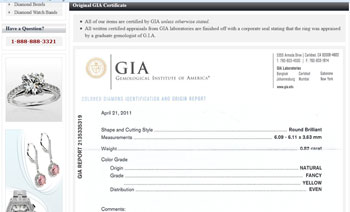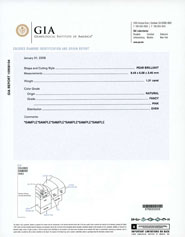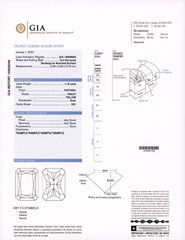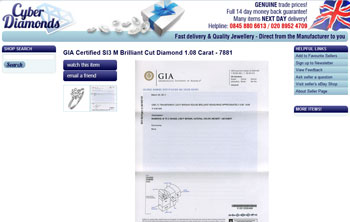GIA & the Magic of Certificates
In magic acts there's often a useful little trick called misdirection: the attention of the audience is led to focus on one thing in order to distract its attention from another. We're seeing that kind of thing happen with diamond certificates online and in the press.
GIA diamond reports are considered the gold standard of diamond certs. Saying a diamond is GIA-certified works like magic in putting people at ease. But let's take a closer look.
Here's a jewelry site that states "All our items are certified by GIA." For one of its colored diamond rings, the site shows a GIA Colored Diamond Identification and Origin Report.
Sounds impressive and looks good at first glance. It's a GIA cert, after all. But this certificate is pretty bare-bones, as far as completeness. It does not include clarity grading, nor does it give any cut information.
What we'd like to have is GIA's more complete cert, the Colored Diamond Grading Report. Compare the two GIA reports below. The Grading Report gives a clarity grade and shows the clarity grading scale so you can see how this gem rates in terms of quality. It also has a diagram indicating inclusions in the stone. This report also carries a diagram with some basic cut proportions (though not all—but that's another story), and it lists a few other details, like polish and symmetry.
Both certificates are from the GIA website. |
|
Why would the seller supply an ID and Origin Report, rather than the more complete Grading Report? If the main concern is verifying the quality of the gem, it would seem that the more information, the better.
But perhaps the seller chose a cert with less information
- because the diamond was heavily included and would have a low clarity grade; or
- because it was poorly cut, and leaving out cut proportions makes it seem more valuable; or
- because the stone was mounted. GIA does not issue the (more complete) Grading Report for mounted stones because the mounting doesn't allow for accurate enough carat weight, clarity grading, or proportion measurements.
Or, maybe the less informative ID & Origin Report was chosen just because it is a less expensive certificate and thus a cheaper way to be able to say the magic words: GIA Certified!
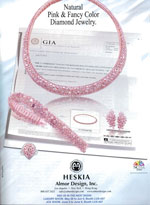 Here's another slick use of GIA's name. The magazine ad on the right shows a GIA cert – again it is the ID and Origin Report – as background for the jewelry. In fact, the GIA name is encircled by the jewelry. But if you compare the cert in the ad with the sample taken from the GIA website (shown above), you can see that the cert in the ad doesn't appear to match the look of the GIA report.
Here's another slick use of GIA's name. The magazine ad on the right shows a GIA cert – again it is the ID and Origin Report – as background for the jewelry. In fact, the GIA name is encircled by the jewelry. But if you compare the cert in the ad with the sample taken from the GIA website (shown above), you can see that the cert in the ad doesn't appear to match the look of the GIA report.
Jewelry sites on the internet blatantly use GIA certs to sell their wares. On the page shown below, the certificate pictured is a Colored Diamond Identification and Origin Report. The cert describes a brown diamond in the W-X color range, though the title of the page announces a diamond with the color grade of M. Both are misleading, because these letter grades are used by GIA for white (colorless) diamonds, not fancy colored diamonds. The title line also says the diamond is of SI3 clarity, but this is a bogus grade that GIA doesn't even use. In short: the report prominently pictured has nothing to do with the diamond being advertised.
Report Check Issue
An additional concern involves verifying the authenticity of the ID and Origin report. GIA has an easy way to check the authenticity of its Colored Diamond Grading Report online: one merely enters the certificate number and the carat weight. However, GIA's online Report Check does not work for their ID and Origin report. This means we cannot check the authenticity of certificates shown by advertisers, consumers cannot check the validity of the cert that came with jewelry they bought, and insurers cannot check the certs that are submitted. It may be possible to verify an ID and Origin report by calling or writing to GIA, but an insurer, or even the customer, is much less likely to do this.
Origin
We see another problem with the Identification and ID and Origin Report, and that is GIA's double use of the term "origin."
Colored gems, such as rubies and sapphires, are often identified by their country of origin because colored gems have features and inclusions characteristic of the area in which they were mined, features that may greatly add to the gems' beauty and appeal. Burmese rubies or Kashmir sapphires, for example, are so identified because their origin plays a big part in their valuation. Origin can be crucial information on a ruby or sapphire certificate.
With diamonds, on the other hand, the country of origin is not important. Diamonds are formed so deep in the earth that, unlike colored gems, they are not affected by the geology of the area where they are brought to the surface.
So why make a big deal of "origin" in the Colored Diamond Identification and Origin Report? Here's the confusion: on the diamond report "origin" refers not to the origin of the stone but to the originof its color. This report states the diamond's color is either natural or due to laboratory enhancement. This is important information, but using the term "origin" with different meanings is confusing.
FOR AGENTS & UNDERWRITERS
GIA is the biggest name in diamond certificates, and with good reason. Because of its name recognition, the GIA name acts as a powerful retail sales tool.
Insurers (and consumers) should bear in mind that "certified diamond" just means it comes with a certificate. How much information is on the certs, and how reliable the information is, can vary a great deal.
A diamond report is not a substitute for an appraisal. A diamond certificate describes only the gem. (And some certs, as discussed above, give less than thorough descriptions). An appraisal is required for a detailed description of the gem and the jewelry as a whole and for a valuation.
Fancy colored diamonds are very rare in nature and quite expensive. For such high-value diamonds, always insist on two appraisals. At least one should be written by an appraiser who holds a Graduate Gemologist or equivalent degree and is a Certified Insurance Appraiser™.
Be sure the appraisal for a fancy colored diamond:
- states whether the gem is natural or lab-made
- states that it is untreated or lists all treatments.
FOR ADJUSTERS
Compare data on all documents - appraisals, diamond reports, and sales receipt – to be sure the information agrees.
For fancy colored diamonds, a selling price that is "too good to be true" is a major red flag. Do ITV (insurance to value) calculations to check for a major discrepancy between the purchase price and replacement cost. JEMs® software makes ITV calculations easy and guards against fraud.
There is a huge value difference between fancies that are naturally colored and those that are color enhanced. Be sure the appraisal specifies natural or enhanced color.
If the appraisal was not written on JISO 78/79, use JISO 18 to verify that all necessary information was given on the appraisal.
In settling claims for fancy colored diamonds, be wary — especially if
- the appraisal does not list treatments, yet does not state that the gem is untreated;
- the only appraisal available is one written by the seller;
- a brand name appears. (Brands can have significance within the industry. Bellataire, for example, signifies an HPHT-treated diamond.) Brand names are often inscribed on the stone's girdle.
If any of the above apply, it may be useful to consult a jewelry insurance expert before settling the claim. The expert, working on your behalf, can help determine whether the valuation is accurate.
Use the following link to verify a GIA report:
If a diamond certificate cannot be verified online, you may want to call GIA to verify it and to get any additional information that may be in GIA's lab file but not on the certificate.
©2000-2025, JCRS Inland Marine Solutions, Inc. All Rights Reserved. www.jcrs.com

